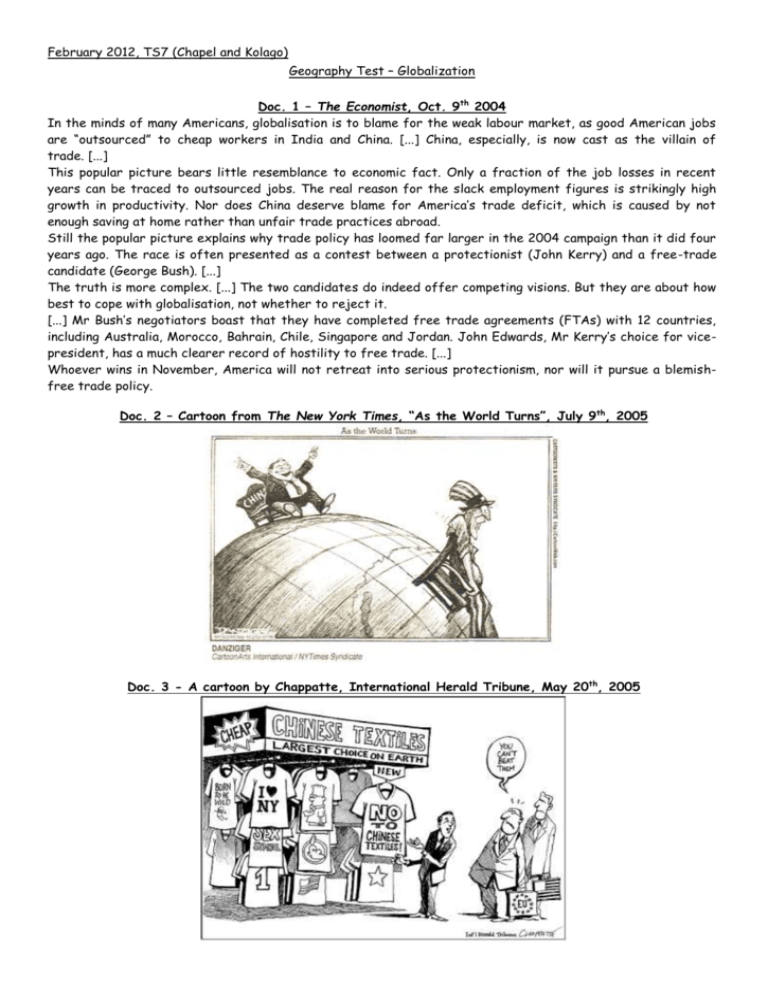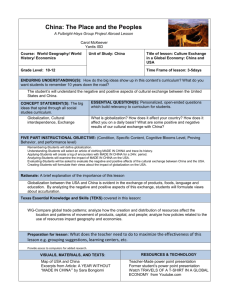Séance de travail – Globalisation
advertisement

February 2012, TS7 (Chapel and Kolago) Geography Test – Globalization Doc. 1 – The Economist, Oct. 9th 2004 In the minds of many Americans, globalisation is to blame for the weak labour market, as good American jobs are “outsourced” to cheap workers in India and China. [...] China, especially, is now cast as the villain of trade. [...] This popular picture bears little resemblance to economic fact. Only a fraction of the job losses in recent years can be traced to outsourced jobs. The real reason for the slack employment figures is strikingly high growth in productivity. Nor does China deserve blame for America’s trade deficit, which is caused by not enough saving at home rather than unfair trade practices abroad. Still the popular picture explains why trade policy has loomed far larger in the 2004 campaign than it did four years ago. The race is often presented as a contest between a protectionist (John Kerry) and a free-trade candidate (George Bush). [...] The truth is more complex. [...] The two candidates do indeed offer competing visions. But they are about how best to cope with globalisation, not whether to reject it. [...] Mr Bush’s negotiators boast that they have completed free trade agreements (FTAs) with 12 countries, including Australia, Morocco, Bahrain, Chile, Singapore and Jordan. John Edwards, Mr Kerry’s choice for vicepresident, has a much clearer record of hostility to free trade. [...] Whoever wins in November, America will not retreat into serious protectionism, nor will it pursue a blemishfree trade policy. Doc. 2 – Cartoon from The New York Times, “As the World Turns”, July 9th, 2005 Doc. 3 - A cartoon by Chappatte, International Herald Tribune, May 20th, 2005 Correction du contrôle - Globalisation Introduction Presentation Definition of Globalization as the increase of interactions between the different parts of the World, characterized by more intensive World-scale flows (goods, capitals, people, information and knowledge), allowed by advanced technologies of information and communication and by mass transport. Some consider it is led by Western countries, and that it is synonymous with Americanization. Presentation of the two documents Key question If the USA is the leader of the Globalization process, can the latter threaten its first / leading position? Can Globalization threaten the American hyperpower? More precisely, is raising China responsible for the slump in American economy? Outline I – America’s first position at stake A – Threatening China Doc. 1 focuses on China (lines 2 and 6), which is the most emerging of all the developing countries. Indeed, its average economic growth reaches 10% per year. Would China be the new leader of Globalization then? Doc. 2 pictures China at the top of the globe, raising triumphantly. It is pictured as a chubby / plump man, wearing a suit and a tie (he is apparently a business man, maybe a CEO or Hu Jintao himself), sitting on an imposing armchair, self-confident, beaming widely, doing a victory sign with his hands. The USA is drawn on the right, pictured as Uncle Sam (strips and stars on the hat), he is slim and badly-dressed (rags). He is trying to stick to his chair which is sliding down. His face is strange: he seems to be scared. Both characters are very different and contrasted. Doc. 3 pictures a man selling Chinese textiles. All the T-shirts display European or American motifs: we recognize the Simpsons, the American flag, catch phrases you can find on American T-shirts… There is even one displaying “no to Chinese textiles”. The discrepancy between the shop and the T-shirts makes the irony: China is able to adapt and does not care about ideology or beliefs. If, to sell its products, it has to display antiChinese catch-phrases, it is no problem. The irony also comes from the weariness of the two European and American representatives. China is properly unbeatable and is flouring the competitors. This drawing pictures the end of the American era, the end of the American century, as the title confirms. A new power is raising, while America is declining. B – Why would China and the other emerging countries threaten the supremacy of the USA? The impact of relocation The author of doc. 1 mentions India and China (line 2): they are the emerging countries which threaten the leading position of America. Why? Because they benefit from relocation. The latter takes advantage of their cheap labour force (line 2) and of their abundant and therefore docile population (China: 1.3 billion people; India: 1 billion people). Relocation mostly concerns unskilled jobs, while conception remains in the country of origin (headquarters don’t move). The aim is to cut production costs. The production is confided to subsidiary firms located in cheaper countries. But is Globalization, and more precisely emerging China, really threatening America’s leading position? What if China was not the “villain” to blame in the end? II – Would emerging countries be an unfounded threat? A – Is China the guilty one? It is easy to blame China for the economic problems America encounters, and especially for the American economic slump (as we know, America is now witnessing an economic recession). China embodies the “villain” that America needs in order to settle its supremacy. It is a popular and easy target, China is the scapegoat. Two reasons are given in doc. 1: the first one is that China steals jobs (thanks to outsourcing) and is therefore responsible for the “weak labor market” (line 1), and the second is that China has recourse to “unfair trade practices” (line 6), that is an allusion to the flooding of Chinese products on the World market. China, as an emerging and therefore threatening country, is highly promoted through the media. B – Other internal problems explain America’s declining position If China is not the villain, who is it then? According to doc. 1, the one to blame is the USA itself. Two reasons are given: Higher productivity (line 6) leads to job losses. Productivity is the ratio between the production and what you need to reach this production. Productivity increases thanks to mechanization for instance, and is synonymous with a loss of unskilled jobs because workers are replaced by machines. The second reason is American’s trade deficit (line 6), i.e. exports are less important than imports. The national debt of the USA is very high (over $15,000 billion). Consumption is too high, the USA lives beyond its means. C – How to cope with this decline? Doc. 1 was published in a very particular context: the 2004 presidential campaign that opposed G. W. Bush to J. Kerry. The almost manichean opposition between both candidates concerning the attitude to face Globalization shows how burning the issue is. On the one hand, J. Kerry advocated a protectionist attitude, to which the USA already resorted after the 1929 crash: protecting the internal market from foreign competition in order to avoid the bad effects of Globalization and emerging China. On the other hand, G. W. Bush advocated an open economy so as to remain competitive, and his administration boasted that the USA had already reached free trade agreements with countries all over the World (North Africa, Latin America, Middle-East, Asia), not to be left aside. The author wants to show that no one has the answer to cope with the American economic slump. Globalization is something you have to deal with, and not something that can be avoided. The debate is too manichean to be really beneficial. Conclusion Is Globalization really threatening America’s supremacy? These documents show that Globalization preoccupies America which is looking for an external factor to explain its own economic slump. The fault to emerging countries or to internal problems? A mixture of both for sure. Our conclusion may consider another aspect: is the USA really on the decline? Is China really emerging, and is China really threatening America? When one considers that the US GDP per capita reached $47,000 in 2010 (IMF) while it did not even reach $4,500 in China, when one consider the internal political difficulties that China encounters and which were highly broadcast with the 2008 Olympic Games, we may wonder if the threat really exists.






